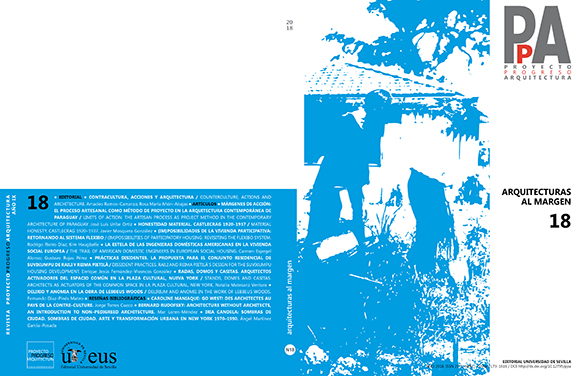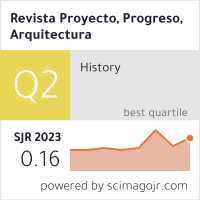GRADAS, DOMOS Y CASITAS. ARQUITECTOS ACTIVADORES DEL ESPACIO COMÚN EN LA PLAZA CULTURAL, NUEVA YORK / STANDS, DOMES AND CASITAS. ARCHITECTS AS ACTUATORS OF THE COMMON SPACE IN LA PLAZA CULTURAL, NEW YORK
DOI:
https://doi.org/10.12795/ppa.2018.i18.06Palabras clave:
Loisaida, jardines comunitarios, deslocalizado, reprogramación, espacio común, red / Loisaida, community gardens, delocalised, reprogramming, common space, networkResumen
RESUMEN En el sudeste de Manhattan, un entramado de más de 50 jardines salpica el tejido reticular del barrio de Loisaida. Desde los años 60, distintos agentes ciudadanos: vecinos, artistas y arquitectos como Matta–Clark o Fuller, implementan los espacios verdes y equipamientos de los que el barrio carece. Mediante procesos y dinámicas afectivo–disidentes, activan espacios comunitarios y autogestionados. A través de arquitecturas cuyos parámetros de generación se alejan del diseño tradicional y de las hegemonías, se apropian de la ciudad y reprograman el espacio público a partir de la creación de espacio común. Gradas, domos y casitas constituyen, con sus formas vernáculas y kitsch, una red cuyo corazón es el histórico solar de La Plaza Cultural. Los jardines comunitarios configuran una red Do it yourself de espacios deslocalizados pero conectados con lo público, tecnificados y con códigos propios que se oponen al mercado inmobiliario, a la invasión mediática, a la globalización y a la apropiación de lo público por parte de lo privado, conformando una infraestructura alternativa de lo común.
SUMMARY In the southeast of Manhattan, a framework of more than 50 gardens dots the reticular fabric of the neighbourhood of Loisaida. From the 1960s, several city agents –neighbours, artists and architects such as Matta-Clark or Fuller– implement the green spaces and public facilities lacking in the neighbourhood. They activate common and self-managed spaces through affective-dissenting dynamics and processes. Making use of architectural elements whose creation parameters are far from the hegemonies and traditional designs, they take the city over and reprogram the public space through the generation of common space. Stands, domes and casitas (tiny-houses) constitute, with their vernacular and kitsch forms, a network whose heart is the historical lot of La Plaza Cultural. Community gardens shape a Do it yourself network of delocalised but related to the status of public spaces, automated and owning their own codes against the real estate market, the invasion of the media, the globalization and the appropriation of the public resources as private, providing an alternative to the ordinary structure.
Descargas
Citas
APTEKAR, Sofya. Visions of Public Space: Reproducing and Resisting Social Hierarchies in a Community Garden. En: Sociological Forum [en línea]. Randolph, N.J.: Eastern Sociological Society, marzo 2015, vol. 30, nº 1, pp. 209–227 [consulta: 13–12–2017]. ISSN–e 1573–7861. Disponible en: https://onlinelibrary.wiley.com/doi/epdf/10.1111/socf.12152 DOI: https://doi.org/10.1111/socf.12152.
BOERI, Stefano; LANZANI, Arturo. Gli orizzonti della città diffusa. En: Casabella. Milán: Electa, 1992, vol. 588, pp. 44–59. ISSN 0008–7181.
BRAND, Steward. Apocalypse Juggernaut Hello. En: Whole Earth Catalog. The Outlaw area [en línea]. Point: Random House, enero 1970 [consulta: 20–08–2017]. Disponible en: http://www.wholeearth.com/back–issues.php.
BROWN–SARACINO, Japonica. Power at the Roots: Gentrification, Community Gardens, and the Puerto Ricans of the Lower East Side. En: Contemporary Sociology [en línea]. Iowa: University of Iowa, Michael Sauder, 2012, vol. 41, nº 4, pp. 498–500. ISSN 0094–3061. ISSN–e 1939–8638. Disponible en: http://journals.sagepub.com/doi/pdf/10.1177/0094306112449614p DOI: 10.1177/0094306112449614.
CANDELA, Iria. Sombras de ciudad. Arte y transformación urbana en Nueva York, 1970–1990. Madrid: Alianza editorial, 2007.
CHODORKOFF, Daniel Elliot. Un milagro de Loisaida: Alternative technology and grassroots efforts for neighborhood reconstruction on New York’s Lower East Side. Michigan: Ann Arbor, 1980.
COROMINAS, Joan. Breve diccionario etimológico de la lengua castellana. Madrid: Gredos, 1973.
DELEUZE, Gilles. En medio de Spinoza. Buenos Aires: Cactus, 2008.
DELGADO, Manuel. Lo común y lo colectivo. Barcelona: Universitat de Barcelona, 2007.
FINN, Donovan. DIY urbanism: implications for cities. En: Journal of Urbanism: International research on placemaking and urban sustainability [en línea]. California: Universidad de Berkeley, 2014, vol. 7, nº 4, pp. 381–398 [consulta: 14–01–2017]. ISSN 1754–9175. ISSN–e 1754–9183. Disponible en: https://www.tandfonline.com/doi/full/10.1080/17549175.2014.891149?scroll=top&needAccess=true DOI: 10.1080/17549175.2014.891149.
FOX, Tom; KOEPPEL, Ian; KELLAM, Susan. Struggle for space: the greening of New York City, 1970–1984. New York: Island Press, 1985.
GONZALEZ, David. “Las casitas”: Oases or illegal shacks? En: The New York Times [en línea]. 20 de noviembre 1990 [consulta: 13–6–2017]. Disponible en: http://www.nytimes.com/1990/09/20/nyregion/las–casitas–oases–or–illegal–shacks.html.
JACOBS, Jane. Muerte y vida de las grandes ciudades americanas. 2ª ed. Madrid: Ediciones Península, 1973.
JACOB, Mary Jane; MATTA–CLARK, Gordon; PINCUS–WITTEN, Robert;
SIMON; Joan. Gordon Matta–Clark: A Retrospective. Chicago: Museum of Contemporary Art, 1985.
KATZ, Cindi. Social formations: Thinking about society, identity, power and resistance. En: Nicholas CLIFFORD; Sarah HOLLOWAY; Stephen PRICE; Gill VALENTINE. Key concepts in geography. London: Sage, 2003,
pp. 249–265.
KAYE, Nick. Site–specific art: performance, place and documentation. En: Theatre research international. London y New York: Routledge, marzo 2002, vol. 27, nº 1. ISSN 0307–8833. DOI: 10.1017/S0307883302371098.
KOOLHAAS, Rem et al. Mutations. Barcelona: Actar, 2000.
LEE, Pamela M. Object to Be Destroyed: The work of Matta–Clark. Cambridge–Londres: The MIT Press, 2001.
LEFAIVRE, Liane; DE ROODE, Ingeborg; FUCHS, Rudolf Herman, ed. Aldo van Eyck: the playgrounds and the city. Rotterdam: Nai Uitgevers Pub, 2002.
MARTINEZ, Miranda J. Power at the roots: Gentrification, community gardens, and the Puerto Ricans of the Lower East Side. Maryland: Lexington Books, 2010.
MATTA–CLARK, Gordon. A Ressource Center and Environmental Youth Program for Loisaida: A Proposal to J. S. Guggenheim Memorial Foundation, 1976. En: Francesca HERNDON–CONSAGRA. Urban Alchemy Gordon Matta–Clark. St. Louis: Pulitzer Foundation for de Arts, 2009.
MORRIS, Robert. Anti Form. En: Artforum. Nueva York: abril 1968, vol. 6, nº 8, pp. 33–35. ISSN 0004–3532.
MOTTEL, Syeus. Charas, the improbable dome builders. New York: Drake Publishers, 1973.
MOURE, Gloria, dir. Gordon Matta–Clark. Museo Nacional Centro de Arte Reina Sofía. Barcelona: Polígrafa, 2006.
MUIR, Peter. Gordon Matta–Clark’s Conical Intersect: Sculpture, Space, and the Cultural Value of Urban Imagery. Burlington: Ashgate Publishing, 2014.
PARR, Adrian. The Deleuze dictionary. Edinburgh: Edinburgh University, 2010.
PASQUALI, Michela. Loisaida. NYC Community Gardens. Ediz. italiana e inglese. Milano: A&Mbookstore, 2006.
POCOCK, Philip; BATTCOCK, Gergory. The Obvious Illusion: Murals from the Lower East Side. New York: George Barziller, 1980.
REAL ACADEMIA ESPAÑOLA. Diccionario de la lengua española. Madrid: Espasa, 2001.
RUSSI KIRSHNER, Judith. The Idea of Community in the Work of Gordon Matta–Clark. En: Corinne DISERENS, ed. Gordon Matta–Clark. London: Phaidon, 2003, p. 148.
SADLER, Simon. Drop City Revisited. En: Journal of Architectural Education [en línea]. Routledge, febrero 2006, vol. 59, nº 3, pp. 5–14. ISNN 1046–4883. ISSN–e 1531–314X. Disponible en: https://onlinelibrary.wiley.com/doi/epdf/10.1111/j.1531–314X.2006.00029.x DOI: https://doi.org/10.1111/j.1531–314X.2006.00029.x.
SCHMELZKOPF, Karen. Urban community gardens as contested space. En: Geographical Review [en línea]. New York: American Geographical Society, julio 1995, vol. 85, nº 3, pp. 364–380. ISSN–e 1931–0846. DOI: 10.2307/215279.
SCHMELZKOPF, Karen. Incommensurability, Land Use, and the Right to Space: Community Gardens in New York City. En: Urban Geography [en línea]. Routledge, 2002, vol. 23, nº 4, pp. 323–343. ISSN 0272–3638. ISSN–e 1938–2847. Disponible en: https://www.tandfonline.com/doi/pdf/10.2747/0272–3638.23.4.323?needAccess=true DOI: https://doi.org/10.2747/0272–3638.23.4.323
SCOTT, Felicity D. Outlaw Territories: Environments of Insecurity/Architectures of Counterinsurgency. Cambridge Massachusetts: MIT Press, 2016.
SCOTT, Felicity D. Acid Visions. En: Grey Room [en línea]. New York: MIT, 2006, nº 23, pp. 22–39. DOI: https://doi.org/10.1162/grey.2006.1.23.22.
SEVCENKO, Liz. Making Loisaida: Placing Puertorriqueñidad in Lower Manhattan. En: Agustín LAÓ–MONTES; Arlene M. DÁVILA, ed. Mambo Montage: The Latinization of New York. New York: Columbia University Press, 2001, pp. 293–317.
SHAPINS, Jesse. Loisaida and the Nuyorican Arts and Activist Movement in the 1970s: Abandoned Lots taken over by Inspiring Thoughts. Director: Owen Gutfreund. Paper. Harvard University Graduate School of Design, 2001 [en línea] [consulta: 14.05 2017]. Disponible en: http://www.pulsate.org/photo/jesse/bio/papers/nuyoricanarts.pdf.
SMITHSON, Robert. Entropy and the New Monument. En: Jack FLAM, ed. Robert Smithson. The collected writings. Berkeley: University of California Press, 1996, pp. 10–23.
SPERLING COCKCROFT, Eva. Toward A People’s Art: The Contemporary Mural Movement. New York: E.P. Dutton, 1977.
TOMKINS, Calvin. Entrevista In the outlaw area. En: New yorker. 8 de enero de 1966, pp. 35–97.
WACQUANT, Loïc JD. Tres premisas nocivas en el estudio del gueto norteamericano. En: Revista INVI. Santiago de Chile: Facultad de Arquitectura y Urbanismo e Instituto de la Vivienda, noviembre 2013, vol. 28, nº 79, pp. 165–187. ISSN 0718–8358.
WALKER, Stephen. Gordon Matta–Clark: art, architecture and the attack on modernism. London: IB Tauris, 2009.
ZEVI, Adachiara. Object to be Destroyed: The Work of Gordon Matta–Clark. Reseña. En: The Art Bulletin. Mass: MIT Press, 2001, vol. 83, nº 3, pp. 569–574. ISSN: 0004–3079. DOI: 10.2307/3177247.
Descargas
Publicado
Cómo citar
Número
Sección
Licencia
Las ediciones impresa y electrónica de esta Revista son editadas por el Secretariado de Publicaciones de la Universidad de Sevilla, siendo necesario citar la procedencia en cualquier reproducción parcial o total.
Salvo indicación contraria, todos los contenidos de la edición electrónica se distribuyen bajo una licencia de uso y distribución “Creative Commons Atribución-NoComercial-SinDerivar 4.0 Internacional” ![]() . Puede consultar desde aquí la versión informativa y el texto legal de la licencia. Esta circunstancia ha de hacerse constar expresamente de esta forma cuando sea necesario.
. Puede consultar desde aquí la versión informativa y el texto legal de la licencia. Esta circunstancia ha de hacerse constar expresamente de esta forma cuando sea necesario.
Los autores/as que publiquen en esta revista aceptan las siguientes condiciones:
- Los autores/as conservan los derechos de autor y ceden a la revista el derecho de la primera publicación, con el trabajo registrado con la licencia de atribución de Creative Commons, que permite a terceros utilizar lo publicado siempre que mencionen la autoría del trabajo y a la primera publicación en esta revista.
- Los autores/as pueden realizar otros acuerdos contractuales independientes y adicionales para la distribución no exclusiva de la versión del artículo publicado en esta revista (p. ej., incluirlo en un repositorio institucional o publicarlo en un libro) siempre que indiquen claramente que el trabajo se publicó por primera vez en esta revista.
- Se permite y recomienda a los autores/as a publicar su trabajo en Internet (por ejemplo en páginas institucionales o personales) antes y durante el proceso de revisión y publicación, ya que puede conducir a intercambios productivos y a una mayor y más rápida difusión del trabajo publicado (vea The Effect of Open Access).









